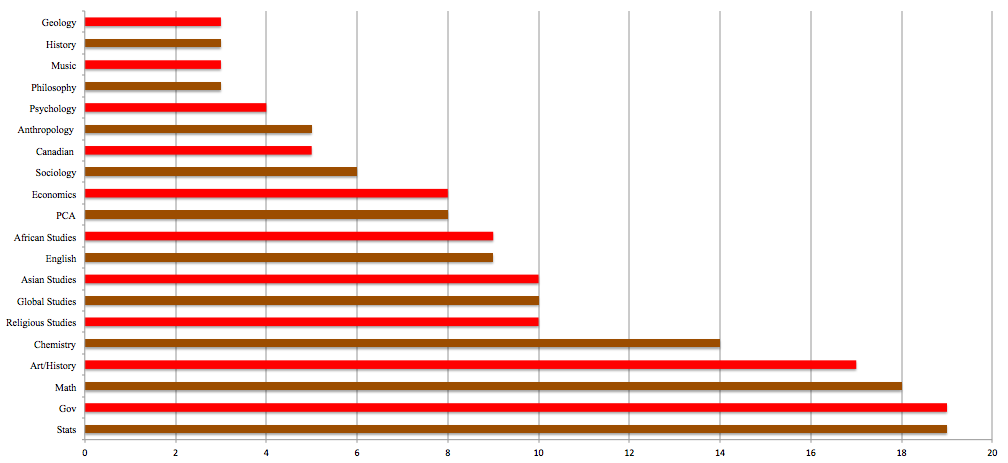What Makes a Major? Exploring the Academic Preferences of SLUdents.
Emma Cummings-Krueger
As soon as the start of Fall 2015 semester, the St. Lawrence student body could potentially include a handful of statistics majors. With the proposal to add a stats major in the final stages of ratification, SLU’s Mathematics Department is prepping for an expansion. The umbrella department expected to add statistics to its two preexistent major programs, math and computer science. With approximately 20 statistics minors in each graduating class and four statisticians at work in Bewkes, the proposed statistics major program is seemingly long-imminent.
To date, the potential statistics major has been approved by SLU’s Board of Trustees and faculty council. The proposal must now gain support from the New York State Department of Education before official approval for the coming Fall semester. Dr. Robin Lock of the Mathematics Department spearheaded the major proposal, “We don’t necessarily expect to draw more students into the mathematics department,” said Lock, “but this will help the ones who are already [involved] to best match their interests to a specific major.”
Even without a future influx of mathematics or statistics majors, the department is already one of SLU’s degree-powerhouses. The combined number of majors and minors in computer science, math, and stats amounted to 101 students in the graduating class of 2014. In addition, mathematics consistently ranks among the top five most popular majors at SLU, according to the Office of Admissions. “We [in the mathematics department] have been wanting for years to get to the point where we’re able to offer [statistics] as a major,” said Assistant Professor of Statistics Ivan Ramler.
Why then, with so much demonstrated popularity, has it taken until now to add a third major to SLU’s Mathematics Department? While other, significantly less populated, academic programs have experienced long-term support from SLU’s administration? The Physics Department, for example, was established at SLU decades ago. However, combined majors and minors from the Physics Department totaled only three among the graduating class of 2014. German Studies, another longstanding program, clocked in with only five majors and minors in the same graduating class.
Although it might seem quite obvious that a minor with nearly 20 recipients in May of 2014 should be prioritized over a major with only two 2014 degree-holders (Canadian Studies), Associate Dean of Academic Administration & Registrar Lorie MacKenzie explains the reasoning behind the delayed addition. “I think the major offerings at St. Lawrence University are well in line with our peer liberal arts institutions,” said MacKenzie, “The faculty members in departments and programs across campus look closely at emerging student demand, national trends, data, and literature from their fields in determining new directions for which they’d like to propose a major.”
The perceived need for new major programs at SLU stems directly from the faculty of each department, drawing from their demand for circular additions. This need is, in turn, determined by indicated student interest, but ultimately favors programs that are “largely interdisciplinary and traditionally considered liberal arts majors,” according to Vice President & Dean of Academic Affairs, Dr. Valerie Lehr. Despite statistics’ departure from this category, “it is a separate field and it is a field in which colleges increasingly offer majors,” said Lehr, “Since we have the faculty necessary to staff a major and student interest, it made sense to the faculty to approve it as a major.”
Although statistics is seeing an overall rise in academic popularity, and the preferences of students at SLU have clearly shown a leaning toward the subject, the same is not necessarily true of undergraduates on a national scale. “I can count on one hand the liberal arts colleges that offer a stats major,” said Lock, “It wasn’t necessarily an inevitable program here because it’s something that’s fairly rare at our peer institutions.” According to Ramler, SLU has a better foundation than most in order to make the appeal for a major. “Most other [peer schools] do not have as much support as we do from full time statisticians,” he said.
The news of SLU’s statistics major has been met with overall support from current stats minors and majors of the general Mathematics Department. “As a Statistics minor, it makes me really happy that they are expanding into a major because students now have the opportunity to gain more experience in the field,” said Gabby Wilson ’15, “I think students will be more interested in committing to a statistics major.” One such student is Molly Sneden ’15, a current mathematics major. “I really love the idea of a stats major,” said Sneden, “I would have definitely considered statistics over math if had been around earlier in my college career.”
The statistics major will require 11.5 academic credits and draw from core mathematics classes already in place at SLU. Major components include additional calculus courses, when compared to the minor, and a new interdisciplinary stats-computer science class introduced within the department. The professors of SLU’s Mathematics Department are confident that the new program will yield success. “It’s pretty clear that statistics is going to be an important [academic] subject, going forward,” said Lock.



